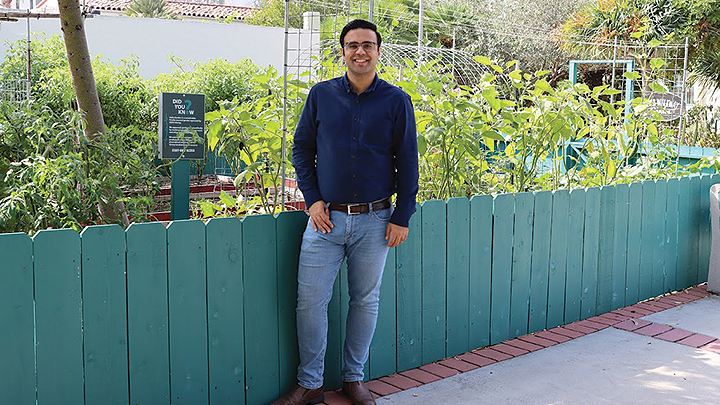The future of farms: It’s electric!
SDSU electrical and computer engineering professor Saeed Manshadi is helping farmers use less energy and transition to more renewable sources.

Originally published in Engage & Innovate - SDSU's Research, Scholarship and Creative Activities Magazine
After building a successful career optimizing the efficiency and safety of electrical grids and powerlines, Saeed Manshadi did not expect a new project would take him back to his roots.
The SDSU electrical and computer engineering professor was raised in suburban areas near Tehran, Iran. He grew up in a house with a large backyard where his parents planted peppers, tomatoes, basil, blackberries and other vegetables. Yet, his hometown suffered under heavy smog from intensive manufacturing, factories and emissions from outdated vehicles.
Visiting SDSU Imperial Valley, Manshadi has observed many parallels to his childhood home. Like Tehran, the Imperial Valley has a hot, arid climate with limited access to water. Despite the desert environment, the Imperial Valley has over 500,000 acres of farmable land and an agricultural industry dating back over a century producing midwinter vegetables such as lettuce, cabbage, cauliflower, and broccoli.
The Southern California region also has its fair share of air quality issues, caused by agriculture and border-crossing traffic, which often exacerbate chronic health conditions in local communities.
“We found that many of these air quality issues are coming from how we transport foods from farms to processing facilities,” explained Manshadi.
The farming industry in the United States contributes 10% of the country’s greenhouse gas emissions. In Imperial Valley, the agricultural sector accounts for over 60% of the county’s greenhouse gas emissions. Manshadi wanted to know where exactly these carbon emissions were coming from, and whether his expertise in renewable energy sources could help move the local agricultural industry toward a net-zero carbon footprint.
Identifying Community Needs
With a Climate Champion grant from the Southern California Gas Company, Manshadi talked directly with Imperial Valley farmers, laborers and community organizations about their livelihoods.
They told him they rely primarily on diesel gas to power tractors and trucks. To conserve precious water resources, farmers use irrigation pumps, also powered by diesel. This fossil fuel releases carbon dioxide and nitrogen gasses into the air, further increasing the global temperature.
“The currency of energy in these farming communities is gallons of diesel; I want this to change to kilowatt-hours,” Manshadi said.
Switching to electric-powered equipment, supplied by cleaner, less carbon-dependent energy sources like solar panels, has the potential to cut down on carbon emissions and improve air quality.
But community members also described trade-offs and barriers to adopting renewable energy solutions. Electric machinery is often heavier, requires hard-to-find charging stations, and currently costs more than already-purchased diesel options.
“The economic incentive might not be there yet,” said Manshadi.
Allocating land for solar panels or electric vehicle charging stations to generate more electricity means there may be less space available for crops.
To make up for the loss of space, Manshadi suggests farmers could implement vertical farming, or the practice of growing crops indoors, in irrigated columns. Cooling vertical farms requires less energy and water than traditional farming, further lowering costs.
Vertical farms can also help save the roughly 20% of solar-generated electricity that goes to waste by flexibly storing or using excess electricity when supply is high and demand is low, such as in the middle of a cool spring day.
“In a nutshell, we are generating food out of unwanted solar energy,” Manshadi said.
Envisioning an Electric Future
To help farmers weigh the pros against the cons, Manshadi developed mathematical models to present the possible outcomes of implementing more sustainable operational changes.
“We tried to answer the question: can we find a way to stop using diesel and use renewables, yet still deliver the energy needed to grow?”
One of his computational models showed infrastructure changes could reduce carbon emissions by up to 70% and decrease demand on the electrical grid by 10%. And he can customize some of the variables to account for individual farmers’ budgets and greatest concerns to identify the most sensible solutions for them.
Armed with these tools and some Spanish-English bilingual brochures (instead of a crystal ball), he showed farmers their potential futures. Without risking damage to crops, the digital demonstration proved that farm electrification has long-term benefits for farmers’ bottom line and health, despite higher upfront costs.
Together with these farmers, he hopes to reduce carbon emissions from agricultural transportation and irrigation in the region by 30% and help improve air quality.
Manshadi will keep optimizing his artificial intelligence model to predict energy needs and solar energy generation on farms based on seasonal weather forecasts. The ultimate goal is to eliminate dependence on fossil fuels entirely.
“Farming is a business, so we want to make sure that the ideas are going to make sense for farmers to grow their renewable capabilities.”
At the root of it all, this research promises a more sustainable future for our farmers, communities, and planet.



